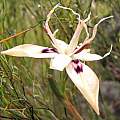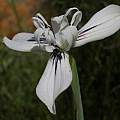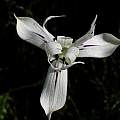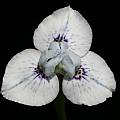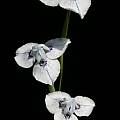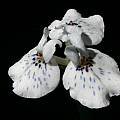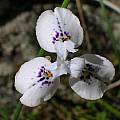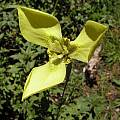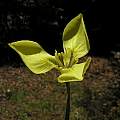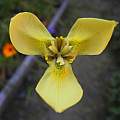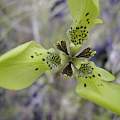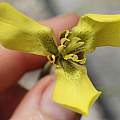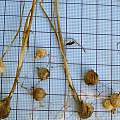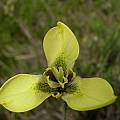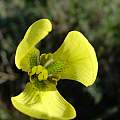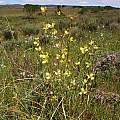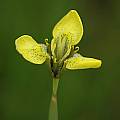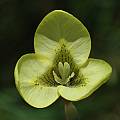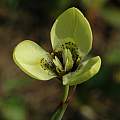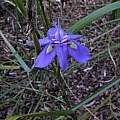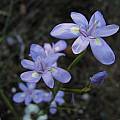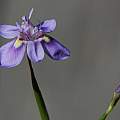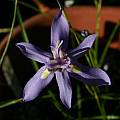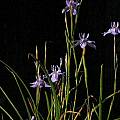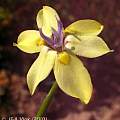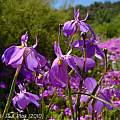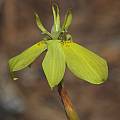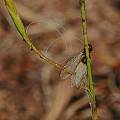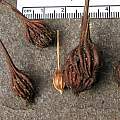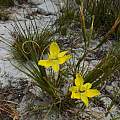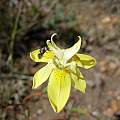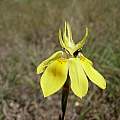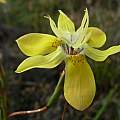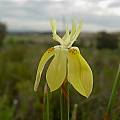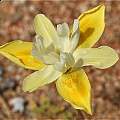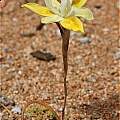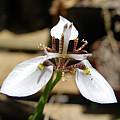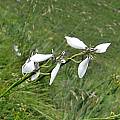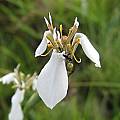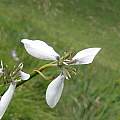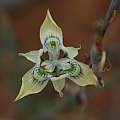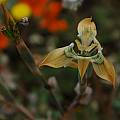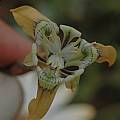The genus Moraea can be divided into five groups: Galaxia, Gynandriris, Hexaglottis, Homeria, and Moraea.
Moraea group species b are found on this wiki page. More information can be learned from Peter Goldblatt's book on Moraeas.
Moraea index lists all the species in all five groups alphabetically.
The other species in the Moraea group are listed alphabetically on these wiki pages: Moraea group a - Moraea group c-e - Moraea group f - Moraea group g-i - Moraea group j-m - Moraea group n-r - Moraea group s - Moraea group t - Moraea group u-v
Moraea barkerae Goldblatt has striking pale pink flowers marked with a dark purple, chevron-shaped nectar guide. It is winter-growing and native to upper elevations of the Cederberg and Cold Bokkeveld Mountains and reportedly blooms well after fires. As far as we know, it's not in cultivation. The photos below were taken in the mountains near Piketberg and Citrusdal by Nick Helme, who writes: "The plants definitely seem to prefer younger veld, but will flower in older veld too. My photos were taken in veld about 4 yrs old, so they are not true pyrophytes. Soil type in that area appeared to be a loamy sand, derived from a mix of shale and sandstone, and they grew on a steep west slope at mid altitude."
Moraea barnardii L.Bolus has a single leaf and white flowers streaked with blue with cream nectar guides outlined in dark blue. The flowers are about 1 inch in diameter and with their blue or black lines and dots they are most charming. The blossom lasts 3-4 days and repeats periodically for 3 weeks. This species is found on rocky sandstone slopes in the southwest Cape. The first three photos by Bob Werra is of one of his favorites. Alan Horstmann took the last photo.
Moraea bellendenii (Sweet) N.E.Br. is a very tall yellow blooming Moraea and one of the last ones to bloom in my garden. In nature it is found on granitic or clay slopes in the southern parts of the Cape. The inner tepals are tricuspidate with short lateral lobes and a slender central cusp curved inwards. The tepals curve upward. It is closely related to Moraea tricuspidata which has white flowers and tepals that spread horizontally. It occasionally skips a year for me and often divides into smaller corms. I have found it grows best in the ground or a very deep container. Photos 1-3 by Bob Rutemoeller and Mary Sue Ittner. Photo 4 was taken by Dirk Wallace. Photos 5-6 by M. Gastil-Buhl show a close-up of a flower from corms received from Michael Mace and the resulting corms from two flowered plants on a 1 cm grid.
The first three photos were taken by Cameron McMaster in the Overberg. The next three photos were taken by Bob Rutemoeller. The first of these was taken near Bainskloof and is very speckled and the second was taken on the West Coast near Darling. The flowers were not entirely open giving it a very different appearance. The last was taken at Lion's Head.
Moraea bipartita L.Bolus is found on clay flats in the Karoo, southern Cape and the Eastern Cape, areas that may have winter rainfall, year round rainfall or even predominantly summer rainfall. Flowers are enclosed in green spathes and are blue with yellow nectar guides. Mary Sue Ittner found that the flowers only open when it is warm and later in the day, closing the same day. Each time she acquired new bulbs they have bloomed the best the first year and then rarely been seen again. They could be from dry areas and not like the excessive winter rainfall she gets. Photo 1 from Bob Rutemoeller. Photos 2 and 3 from Mary Sue Ittner. The first was discovered in 2004 returning in the ground, late one afternoon as the light was fading. Photo 3 was taken in 2009. Photos 4-5 were taken by Bob Werra who writes: "This species is a bit unpredictable but sets a lot of seed without help. Each flower is fugacious but many blossoms are open at a time and it continues to repeat with new blooms for weeks."
Photos below from the book Plants of the Klein Karoo courtesy of Jan and Anne Lise Schutte-Vlok. They describe this species as usually about 20 cm tall, but sometimes up to 40 cm with two to four narrow leaves. Branched flowering stems carry many flowers in spring, flowering abundantly after good rains.
Moraea bituminosa (L.f.) Ker Gawl. has sticky stems as can be seen in the picture as an insect is stuck to the stem. It is found in the higher rainfall areas of the southwestern Cape where is grows usually on stony sandstone soils, but also on mixed sandy clay. It flowers late in the season. It is branched with flowers opening late afternoon. The first two photos by Mary Sue Ittner show flowers growing in cultivation blooming mid June 2005. The third photo shows the corms. The last photo from Rod Saunders.
Photos from Cameron McMaster taken in the Overberg
Moraea bolusii Baker grows on rocky flats and hills in thin sandy soils in Namaqualand. This species is from 7 to 20 cm high and has a long solitary trailing leaf with crisped or undulate margins and pale yellow and white flowers with deeper yellow nectar guides on the outer tepals. It flowers September to October with flowers opening early afternoon and fading by sunset. Photos taken by Andrew Harvie northeast of Springbok in Namaqualand.
Moraea brevistyla (Goldblatt) Goldblatt is found in the Eastern Cape where it grows in grassland, often near streams and damp areas. It has a solitary leaf and small white to pale lilac flowers that are grey to purple underneath with yellow nectar guides with brown spots. Photos taken by Cameron McMaster at Mt. Thomas and also at Sentinel Peak in the Drakensberg Mountains of KwaZulu-Natal.
Moraea bubalina Goldblatt grows on rocky sandstone or shale slopes in the northwest Cape and the western Karoo. It has brownish flowers with yellow to cream nectar guides on the inner and outer tepals. This population was seen in the Bokkeveld Plateau in September 2006. Photos by Mary Sue Ittner and Bob Rutemoeller show several different forms of the flowers and also the whole plant.
Galaxia - Gynandriris - Hexaglottis - Homeria a-j - Homeria k-z - Moraea group a - Moraea group c-e - Moraea group f - Moraea group g-i - Moraea group j-m - Moraea group n-r - Moraea group s - Moraea group t - Moraea group u-v - Moraea Hybrids - Moraea index
